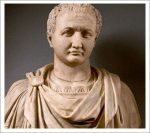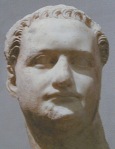 Vespasian was fortunate enough to have 2 sons, and he took steps to cement a new dynasty among Roman Emperors before his sudden death from illness in 79 AD. His oldest son, Titus, was actively groomed as his successor and even ruled with his dad in an unofficial role as co-emperor behind the scenes. Vespasian also left Titus to finish the work of defeating the Jewish revolt, seeing that is son would gain military glory. When Titus was finally emperor, many were convinced he would be the next Nero. Give credit to Titus though- his number 1 priority was to please the people and get on their good side, which he did in his 2 (yes, only 2 years) as Emperor. Two major disasters hit Rome in those years. First, Mt. Vesuvius erupted and destroyed the Roman towns of Pompeii and Herculaneum in the south. Second, another major fire swept the city and destroyed much of it. In both cases, Titus was quick to send disaster relief and begin rebuilding efforts. The massive Flavian amphitheater (or Colosseum) which Vespasian ordered built, was completed and inaugurated with 100 strait days of games. In short order, Titus drained lots of funds but won the favor of Rome. Then, when all was going great, he died suddenly of illness at age 42, probably of malaria. All of Rome mourned, and in death Titus became something of a hero.
Vespasian was fortunate enough to have 2 sons, and he took steps to cement a new dynasty among Roman Emperors before his sudden death from illness in 79 AD. His oldest son, Titus, was actively groomed as his successor and even ruled with his dad in an unofficial role as co-emperor behind the scenes. Vespasian also left Titus to finish the work of defeating the Jewish revolt, seeing that is son would gain military glory. When Titus was finally emperor, many were convinced he would be the next Nero. Give credit to Titus though- his number 1 priority was to please the people and get on their good side, which he did in his 2 (yes, only 2 years) as Emperor. Two major disasters hit Rome in those years. First, Mt. Vesuvius erupted and destroyed the Roman towns of Pompeii and Herculaneum in the south. Second, another major fire swept the city and destroyed much of it. In both cases, Titus was quick to send disaster relief and begin rebuilding efforts. The massive Flavian amphitheater (or Colosseum) which Vespasian ordered built, was completed and inaugurated with 100 strait days of games. In short order, Titus drained lots of funds but won the favor of Rome. Then, when all was going great, he died suddenly of illness at age 42, probably of malaria. All of Rome mourned, and in death Titus became something of a hero.
It should be said that these 2 Emperors remain enigmas. We know about them from the writings of Roman historians, but those are often tricky to take at face value. As each of the Emperors were glorified or reviled in death, the stories carry bias and it’s hard to know what is true. For instance, the horrible stories of Nero contain elements of truth based in real historical events, but were written much later by historians who were out to discredit and demonize him. We must take this in mind whenever we study these figures. Titus certainly did a lot in only 2 years and went down among Romans as one of the great rulers, but it’s hard to say if he was really a decent ruler or not. The story of his successor Domitian, is one of the toughest to get to the bottom of. Over time, he has gone down in history with the likes of Caligula and Nero, but the evidence of his reign paints a more complex portrait then that of a tyrant.

Domitian was the younger son of Vespasian and brother of Titus, and since Titus didn’t have an heir he moved quick to make sure he was next in line. He was declared Emperor in 81 and began his 15 year rule in a difficult position. Many assumed that Domitian had poisoned his brother to get the throne, though there’s no evidence that he did. By all accounts, Domitian was a cold, power-hungry dictator. He saw no reason whatsoever to pretend (as his predecessors had) that the senate held any power over him, so he moved quickly to take total control. At the same time, he launched more huge building campaigns and wars on the empires outer borders. Historians paint him as unhappy, insecure and paranoid, always on the lookout for those wishing him harm. He had many prominent senators put to death or exiled. It’s never been proven, but some ancient sources say Domitian persecuted Jews and early Christians as well. In the end, he was assassinated as part of an elaborate plot. It goes without saying that the senate and other higher-ups hated Domitian for his abuses of power, but then, they also wrote the histories. For most Romans though, life was peaceful under Domitian. It would seem that for all his shortcomings, Domitian was an effective ruler who, for a time, maintained order and helped Rome to prosper.
 He left his mark in Ancient Rome in the form of buildings. He restored temples in the forum after the fire of 80, and dedicated the huge arch of Titus to his late brother. Today, just west of the Colosseum and south of the Forum are the remains of the palace on the Palatine hill, the mythical hill in Rome where Romulus and Remus were nursed by the she-wolf and the location of Rome’s first settlement. Domitian had the hill leveled off and completely rebuilt with a 440,000 square foot palace overlooking the Circus Maximus on one side and the Forum on the other. It’s in pretty bad shape today, but you can still tell from the size of the foundation and wall fragments how enormous it was. The complex had many separate buildings and private residences, all painted with elaborate paintings and furnished with the finest stone from across the empire. A huge extension of the aqueduct was made to bring water directly to the palace. Domitian is said to have been so afraid of conspirators, that he had columns installed made of reflective white marble so he could always see behind him.
He left his mark in Ancient Rome in the form of buildings. He restored temples in the forum after the fire of 80, and dedicated the huge arch of Titus to his late brother. Today, just west of the Colosseum and south of the Forum are the remains of the palace on the Palatine hill, the mythical hill in Rome where Romulus and Remus were nursed by the she-wolf and the location of Rome’s first settlement. Domitian had the hill leveled off and completely rebuilt with a 440,000 square foot palace overlooking the Circus Maximus on one side and the Forum on the other. It’s in pretty bad shape today, but you can still tell from the size of the foundation and wall fragments how enormous it was. The complex had many separate buildings and private residences, all painted with elaborate paintings and furnished with the finest stone from across the empire. A huge extension of the aqueduct was made to bring water directly to the palace. Domitian is said to have been so afraid of conspirators, that he had columns installed made of reflective white marble so he could always see behind him.
Domitian also built a great stadium of his own across town (as if Rome didn’t already have enough venues for chariot racing and gladiatorial fights). Today, one of Rome’s most famous Piazzas occupies the spot. The Piazza Navona, when viewed from the air, still has the elongated horseshoe shape of Domitian’s stadium. Here’s a model of what Domitian’s stadium looked like and Piazza Navona from the air:


 In the first century, the towns of Pompeii and Herculaneum in southern Italy were the Roman equivalent of Malibu or Beverly Hills. They were established towns filled with the huge vacation houses of Rome’s wealthy elite. Of course, they also had sizable populations of regular people too. Those towns, along with the modern mega-city of Naples, rest on the slopes of Mt. Vesuvius, among the most famous volcanos in the world. In 79 AD, a huge eruption sent avalanches of molten rock and poisonous gas that killed everyone who remained in Pompeii and Herculaneum. It also buried those towns in 70+ feet of ash, effectively wiping them off the face of the earth.
In the first century, the towns of Pompeii and Herculaneum in southern Italy were the Roman equivalent of Malibu or Beverly Hills. They were established towns filled with the huge vacation houses of Rome’s wealthy elite. Of course, they also had sizable populations of regular people too. Those towns, along with the modern mega-city of Naples, rest on the slopes of Mt. Vesuvius, among the most famous volcanos in the world. In 79 AD, a huge eruption sent avalanches of molten rock and poisonous gas that killed everyone who remained in Pompeii and Herculaneum. It also buried those towns in 70+ feet of ash, effectively wiping them off the face of the earth.




